Philips PUS8359 is a television that catches the eye mainly thanks to its three-sided Ambilight system. The backlighting that adapts to the image is impressive, especially in the evening – the light behind the screen adds atmosphere while watching films and makes the interior look more interesting. It's a really nice addition, especially if we enjoy unconventional solutions. For gamers, this model can be a good choice to start with. The low input lag, which is less than 10 ms, ensures quick reactions, and the Automatic Game Mode adjusts the settings to ensure smooth gameplay. If we play occasionally, the television performs well, but it is rather not equipment for those who seek top-notch experiences. In terms of everyday use, it is not perfect. The Titan OS looks simple, but it lacks many popular applications, which can be frustrating. Additionally, the interface can operate slower than we would like – switching applications or navigating between settings can sometimes require patience. If we have previously used more advanced systems like Android TV, Titan OS may disappoint us significantly. And what about picture quality? Here lies the problem. The panel offers average brightness and low contrast, so in bright rooms, the image can look washed out. In darker scenes, black becomes more grey, which diminishes details. HDR? One should not expect great effects – the lack of Dolby Vision and limited technical capabilities mean that HDR content does not make much of an impression. Philips PUS8359 is a television that will serve well for Ambilight fans and those looking for basic features. It performs well in games, and evening viewings with the impressive backlighting will gain an added atmosphere. However, if we care about high image quality or an advanced Smart TV system, it is worth looking for other models. This television is a proposition for those who do not expect too much and want something simple with an interesting visual effect.
- Matching (Score)
- Our verdict
- TV appearance
- Where to buy
- Contrast and black detail
- HDR effect quality
- Factory color reproduction
- Color reproduction after calibration
- Smoothness of tonal transitions
- Image scaling and smoothness of tonal transitions
- Blur and motion smoothness
- Console compatibility and gaming features
- Input lag
- Compatibility with PC
- Viewing angles
- TV efficiency during daytime
- Details about the matrix
- TV features
- Apps
- Playing files from USB
- Sound
Philips PUS8359 (IPS) vs Philips PUS8500
Direct compare
PUS8359 / PUS8349
PUS8500 / PUS8560 / PUS8510 / PUS8600

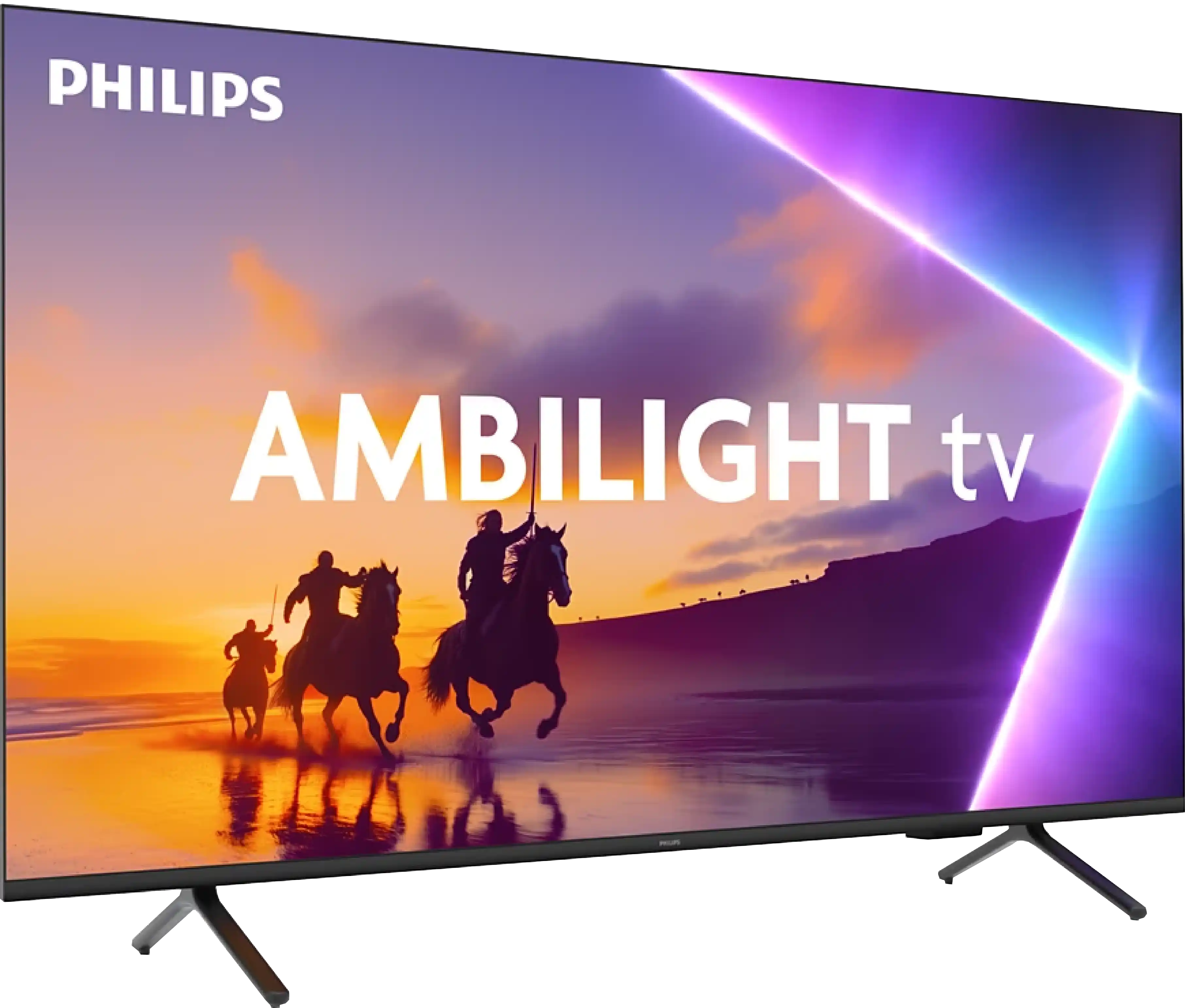
Panel type: LCD IPS
Resolution: 3840x2160
System: Titan OS
Model year: 2024
Complete the survey to find out the result

Panel type: LCD VA
Resolution: 3840x2160
System: Titan OS
Model year: 2025
Complete the survey to find out the result

Overall rating
5.1
5.6
Movies and series in UHD quality
4.3
5.4
Classic TV, YouTube
4.5
6.1
Sports broadcasts (TV and apps)
4.6
5.2
Gaming on console
6.2
6.7
TV as a computer monitor
6.0
5.6
Watching in bright light
4.3
4.9
Utility functions
5.7
4.9
Apps
6.2
4.6
Sound quality
6.1
6.2
Complete the survey to find out what fits your preferences
Advantages
Ambilight 3
Illuminated remote control
Basic functions for gamers
Low input lag
Support for all audio formats (Dolby and DTS)
Ambilight System
High native contrast - VA panel
Low input lag
Basic gaming features: ALLM and VRR
Full support for audio formats: Dolby Atmos and DTS
Backlit remote control with numeric keypad
Disadvantages
Poor black levels and contrast
Average brightness
Limited TitanOS system
Average panel brightness
The TitanOS system seems unfinished (some features do not work, missing applications)
Infrared remote control
Issues with font readability (PC)
Our verdict
Ambilight, as this is what we need to start with, is the biggest reason why it's worth buying the PUS8500. The three-sided backlighting of the television looks fantastic, especially in the evening. It creates an atmosphere, masks contrast shortcomings, and makes watching a film simply more enjoyable. Even if the black levels aren't perfect, the native VA panel offers decent performance at high contrast. Additionally, there’s quite a good input lag and several features for gamers such as ALLM and VRR. Although HDMI 2.1 and a 120Hz panel are absent, playing casually should be a pleasure. Especially since it feels responsive and without delays. Let’s also mention the full support for audio formats – both Dolby Atmos and DTS are included, so soundbar owners can also rejoice.
However, we won't sugarcoat it – this is still a budget television, and at times it’s clearly evident. The brightness is average – not weak enough to prevent viewing, but on an exceptionally sunny day, watching without curtains can be problematic. Nevertheless, in our opinion, the biggest disappointment of the PUS8560 is the Titan OS operating system. Despite the fact that the system debuted some time ago, certain functions simply refused to work – for instance, screen mirroring from a phone despite the manufacturer claiming that such a feature is present. There are fewer apps than in the competition, and the system itself operates rather clumsily. Generally, while it does have some features, it evidently lacks refinement.
Of course, this isn’t a television meant to compete with top models. But if someone is looking for something simple, with a great atmosphere provided by the Ambilight system, it is quite a fair proposition. You just have to know what to expect and accept the numerous compromises present here.
TV appearance





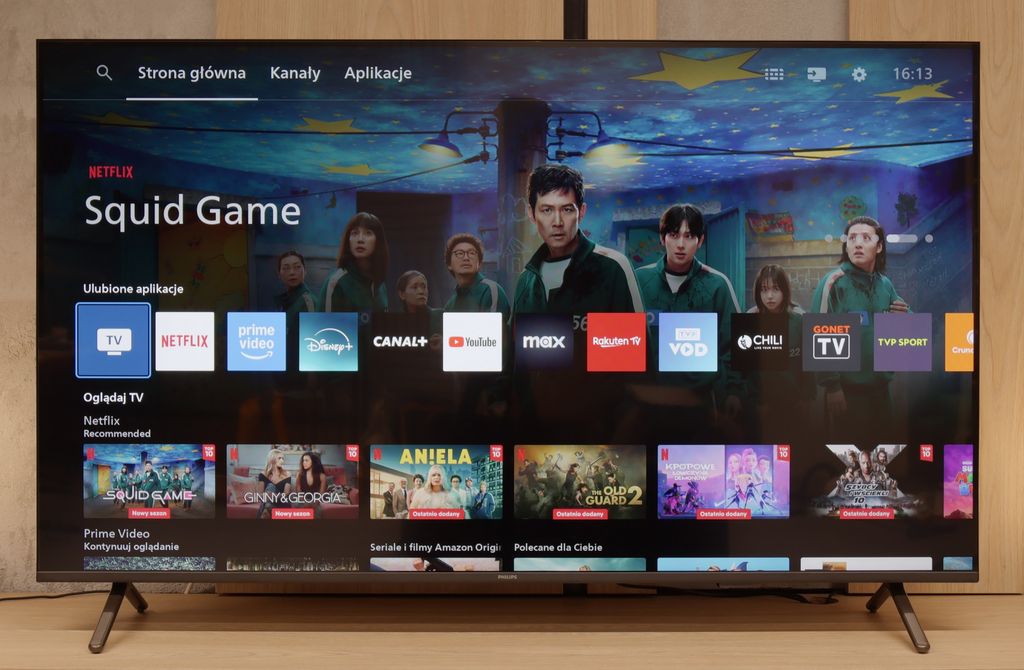
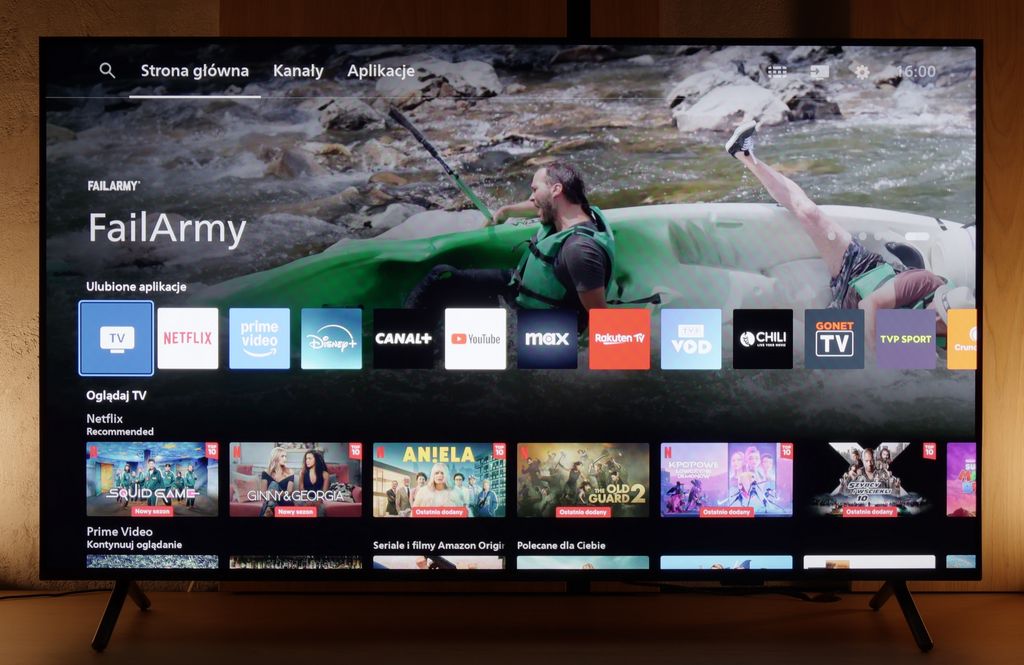
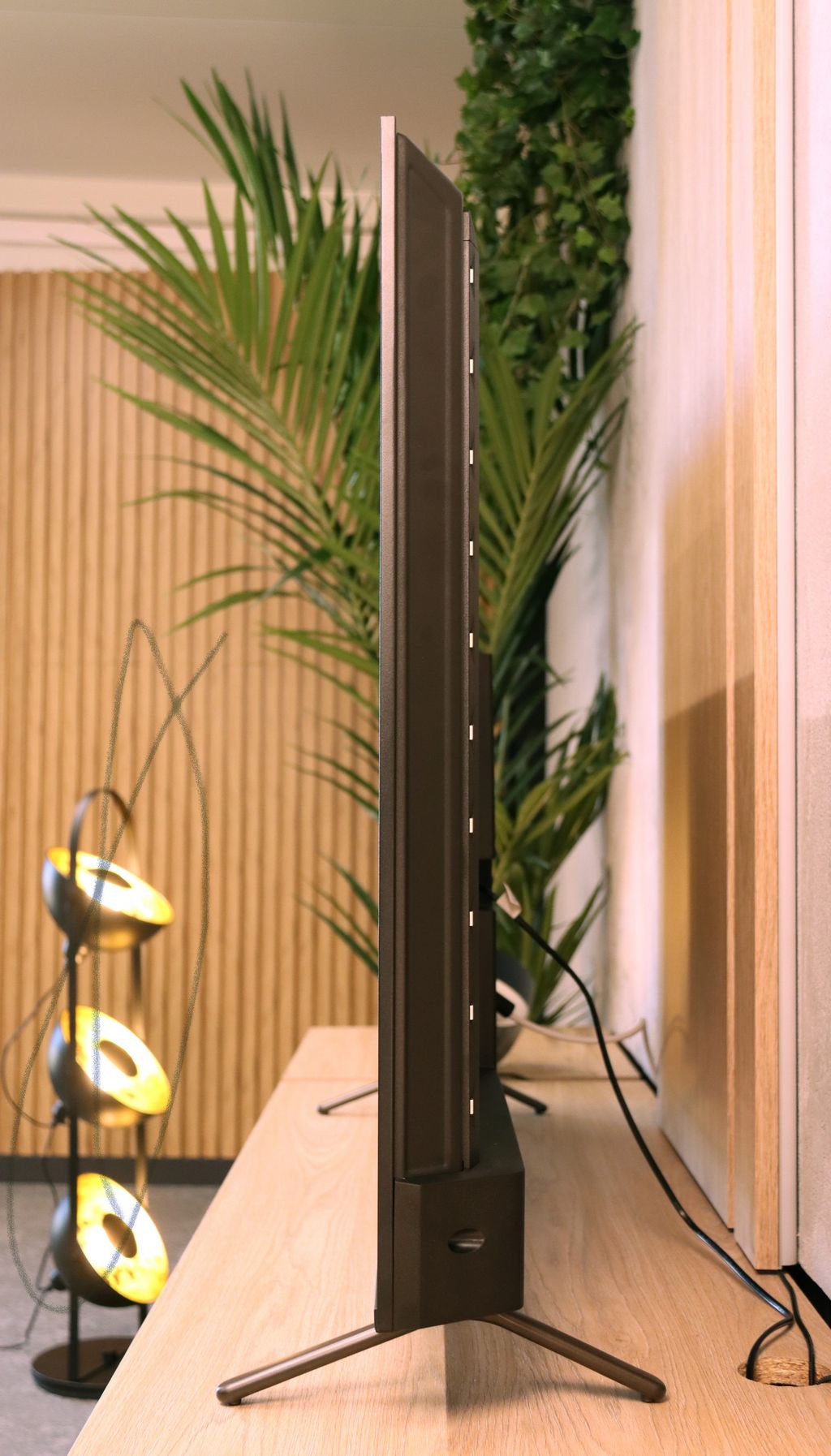
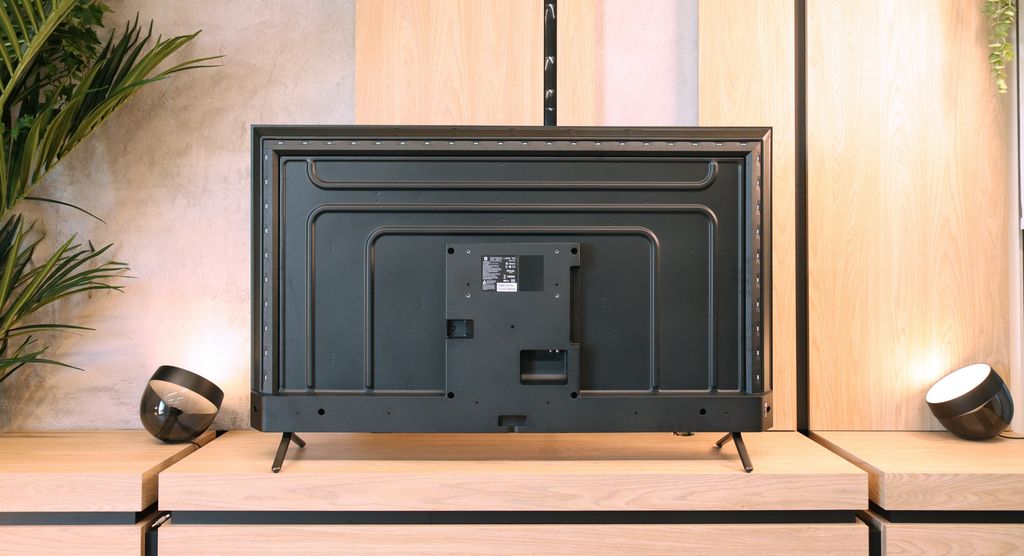
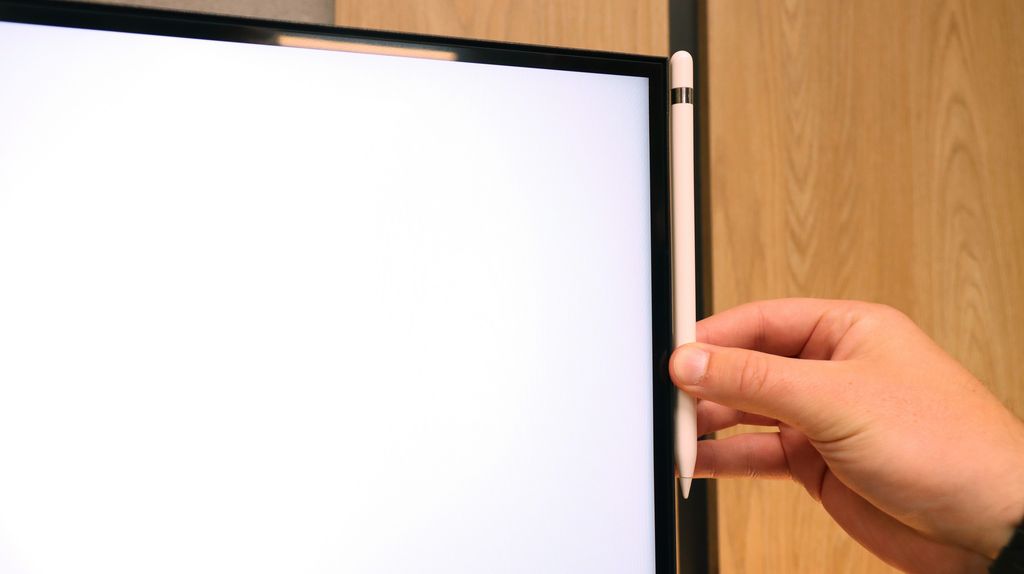
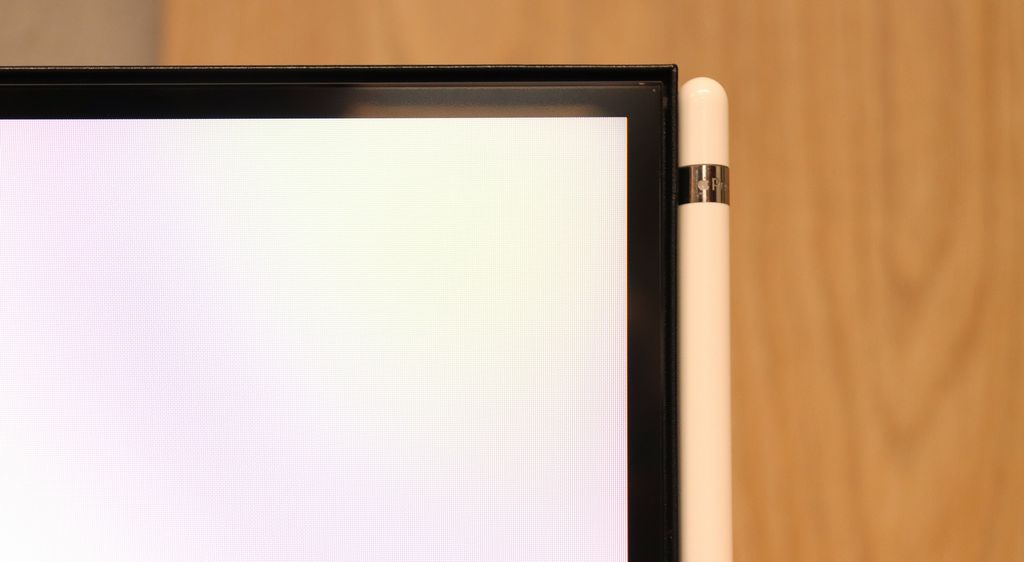

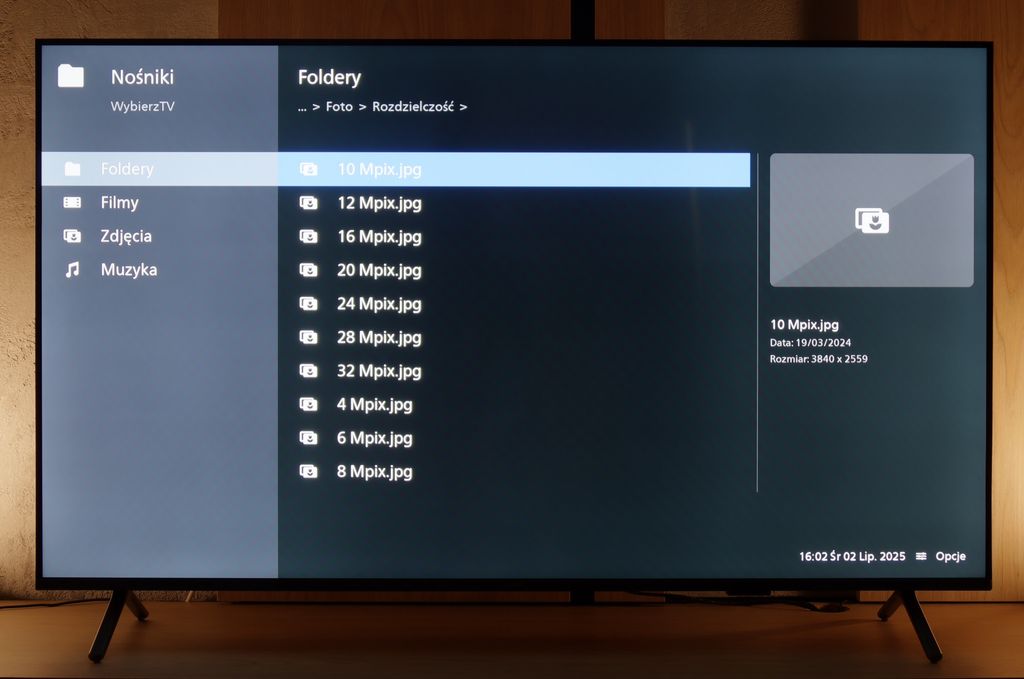
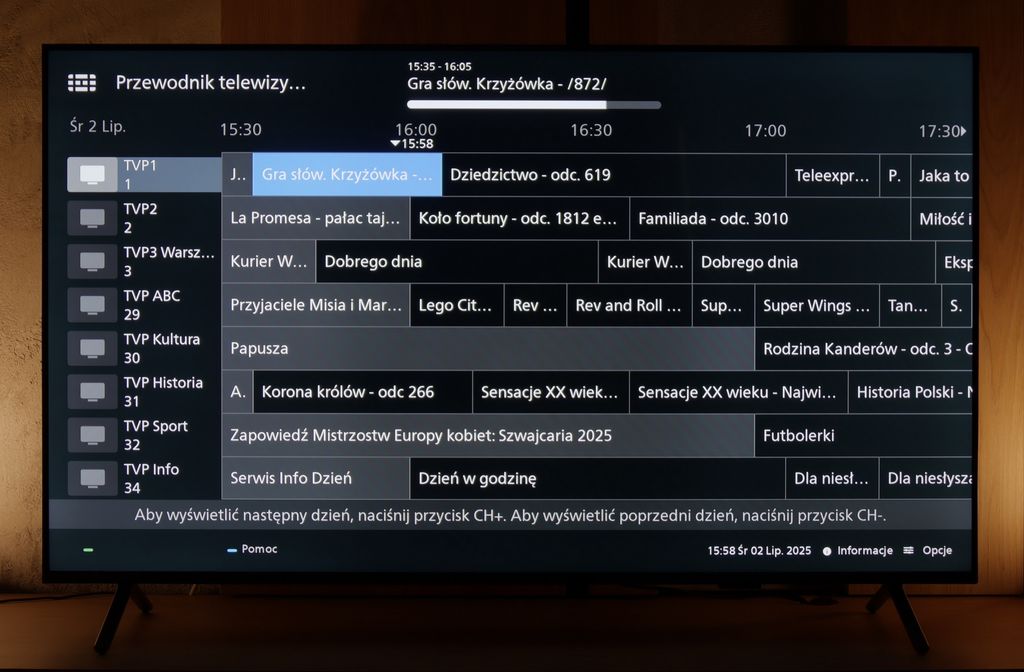
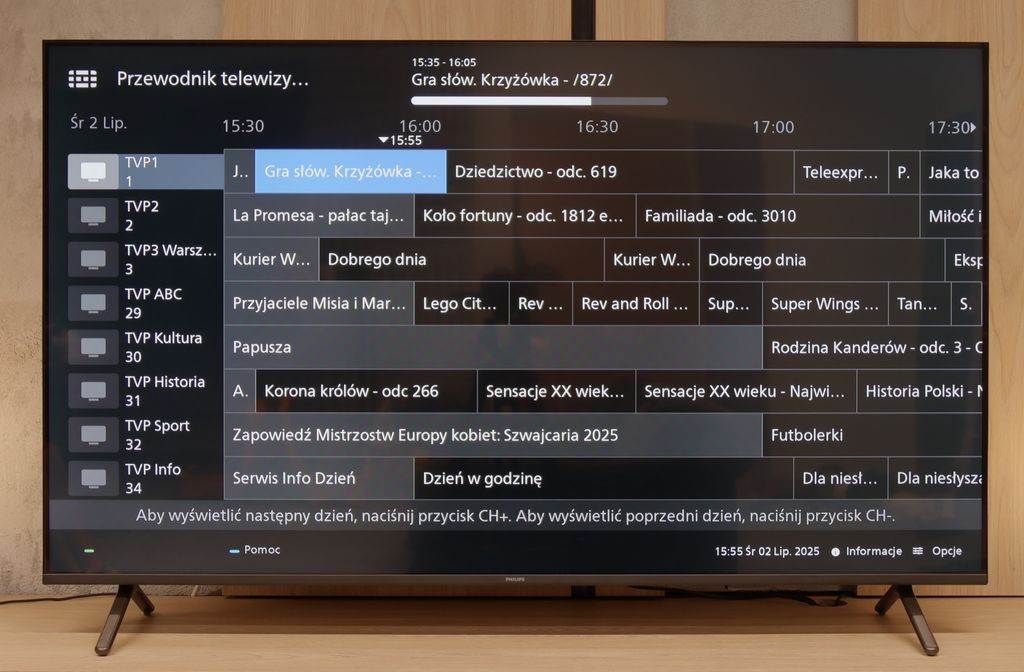
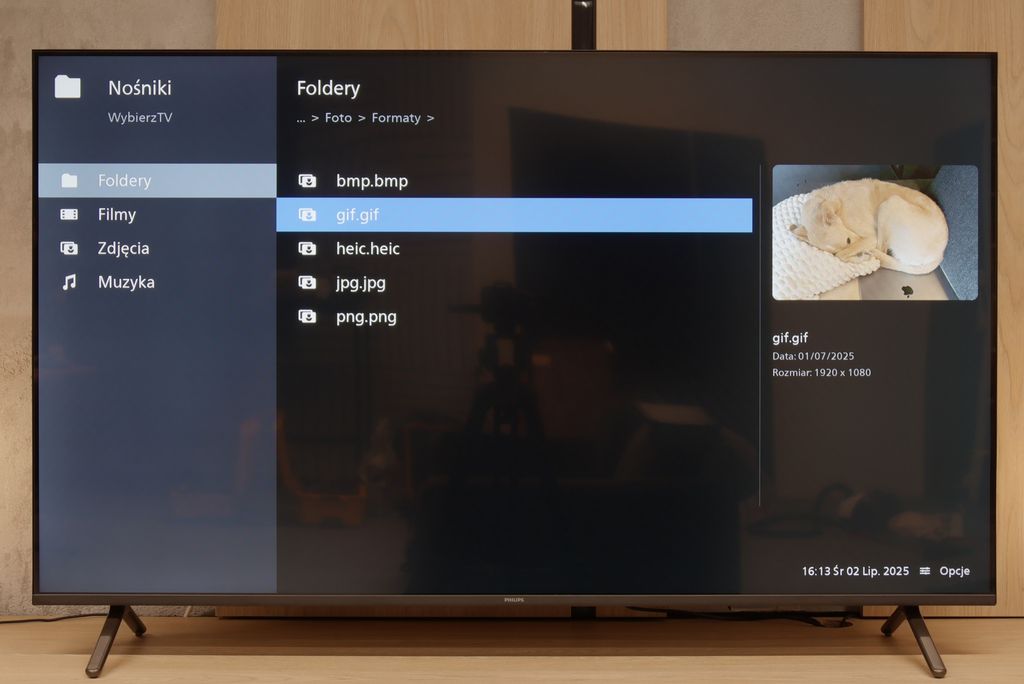
Contrast and black detail
1.9/10
6.1/10
Local dimming function: No
Local dimming function: No
Contrast:

Result
1,000:1

Result
1,050:1

Result
900:1

Result
1,050:1

Result
850:1

Result
6,000:1

Result
5,950:1

Result
6,250:1

Result
5,950:1

Result
5,750:1
Halo effect and black detail visibility:

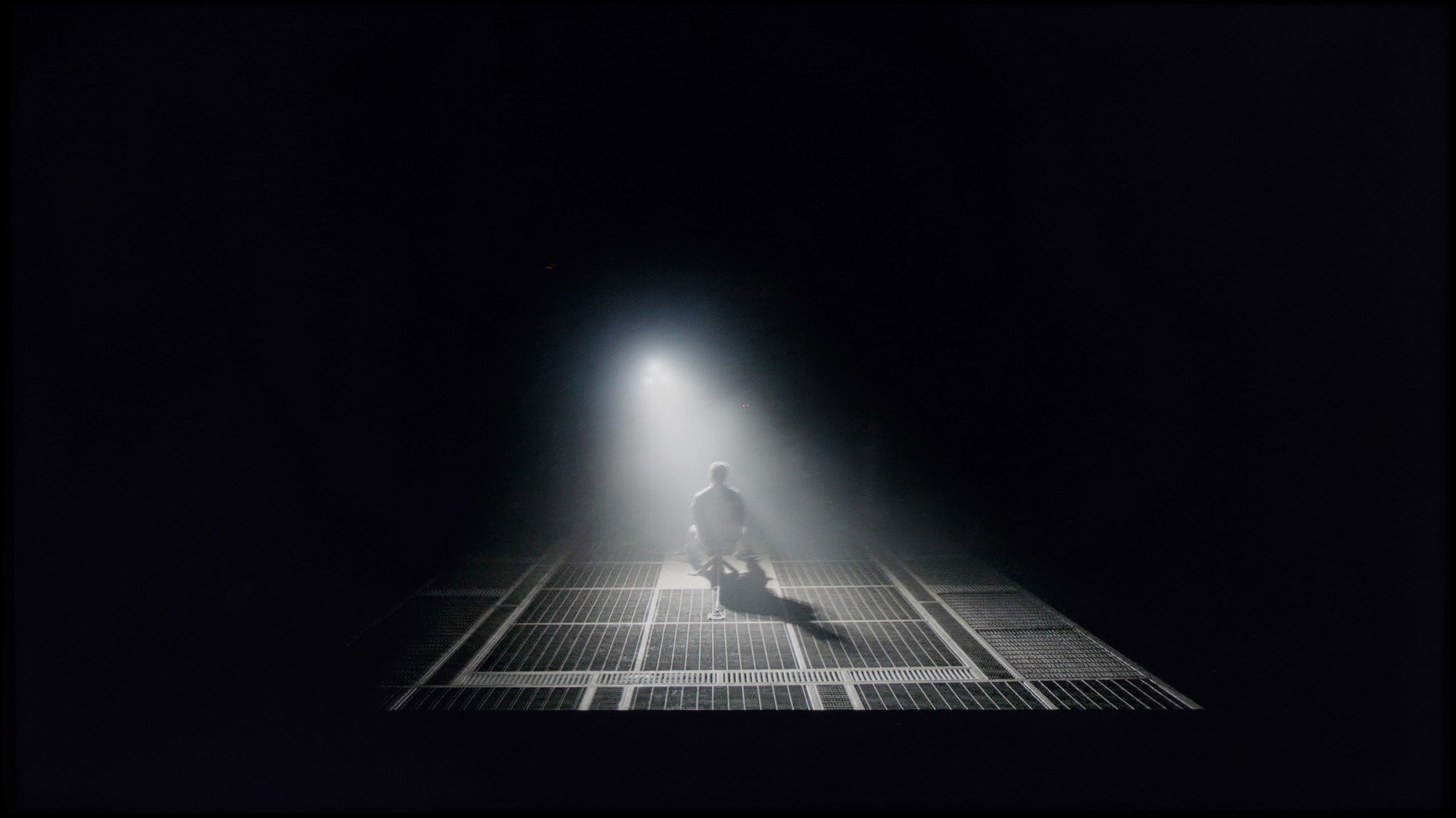

Philips PUS8359/12 in the 55" and 43" versions is based on an IPS panel, which significantly affects the quality of contrast. Unfortunately, test results clearly show a very low level. The blacks, instead of resembling deep tar, appear more like silver ash, which is particularly noticeable when watching dark scenes. Such a level of contrast limits the ability to fully enjoy the picture, especially for those who prefer viewing in darkened rooms.
The Philips PUS8560 in the size we tested is equipped with a VA panel. As a result, black levels – as far as LCD televisions go – can be deemed decent. And that is exactly the case with this model. Both black levels and the overall impression of contrast in the film scenes we tested were really quite good – the image does not bleed, and details are visible even in challenging sections.
But the panel alone is not everything. Unfortunately, the PUS8500 does not come with local dimming (which is a given considering the television segment), so one must be aware that in completely dark conditions, the black can resemble shades of navy more than true black. On the other hand – and here’s a plus for Philips – the Ambilight system does an excellent job. The backlighting genuinely affects the perception of contrast. Therefore, even if technically the black is not perfect, subjectively the viewing experience becomes much more pleasurable. For many people, this is enough to make an evening screening truly impressive.
HDR effect quality
3.6/10
4.1/10
Luminance measurements in HDR:

Result
240 nit

Result
225 nit

Result
285 nit

Result
236 nit

Result
280 nit

Result
273 nit

Result
300 nit

Result
324 nit

Result
343 nit

Result
334 nit
Scene from the movie “Pan” (about 2800 nits)


Scene from the movie “Billy Lynn” (about 1100 nits)


Static HDR10


Dynamic: HDR10+
Dynamic: HDR10+


HDR luminance chart:
Philips PUS8500
Luminancja HDR
Luminance of RGB colors
Philips PUS8359 (IPS)
Luminancja HDR
Luminance of RGB colors
The quality of the HDR effect on the Philips PUS8359/12 TV is also not impressive. The brightness level of 280 nits is too low, resembling standard SDR more than true HDR, which is clearly visible on the five tested test patterns. Additionally, the television does not excel in terms of colour gamut coverage – a mere 76% of DCI-P3 is a result that can be considered poor, especially compared to other models in a similar price range.
When it comes to the HDR effect on the PUS8560, it can fairly confidently be stated that it is very average. The panel brightness is around 350 nits, which we consider to be the absolute minimum for watching content in this format. However, this is not a result that will astonish a viewer searching for the best possible picture.
On the plus side, it is worth noting that the PUS8500 series – including the PUS8560/12 we tested – is advertised as a QLED television. And indeed, we can expect a wider colour spectrum here. This model is equipped with an additional filter (PFS), and a DCI-P3 colour coverage of around 90% should suffice for the majority of users. This filter works very similarly to quantum dots. As a result, the colours are quite well saturated. It is not an outstanding result, but it is entirely sufficient for watching films and series from streaming platforms.
Factory color reproduction
4/10
6.2/10


Factory Mode
After calibration

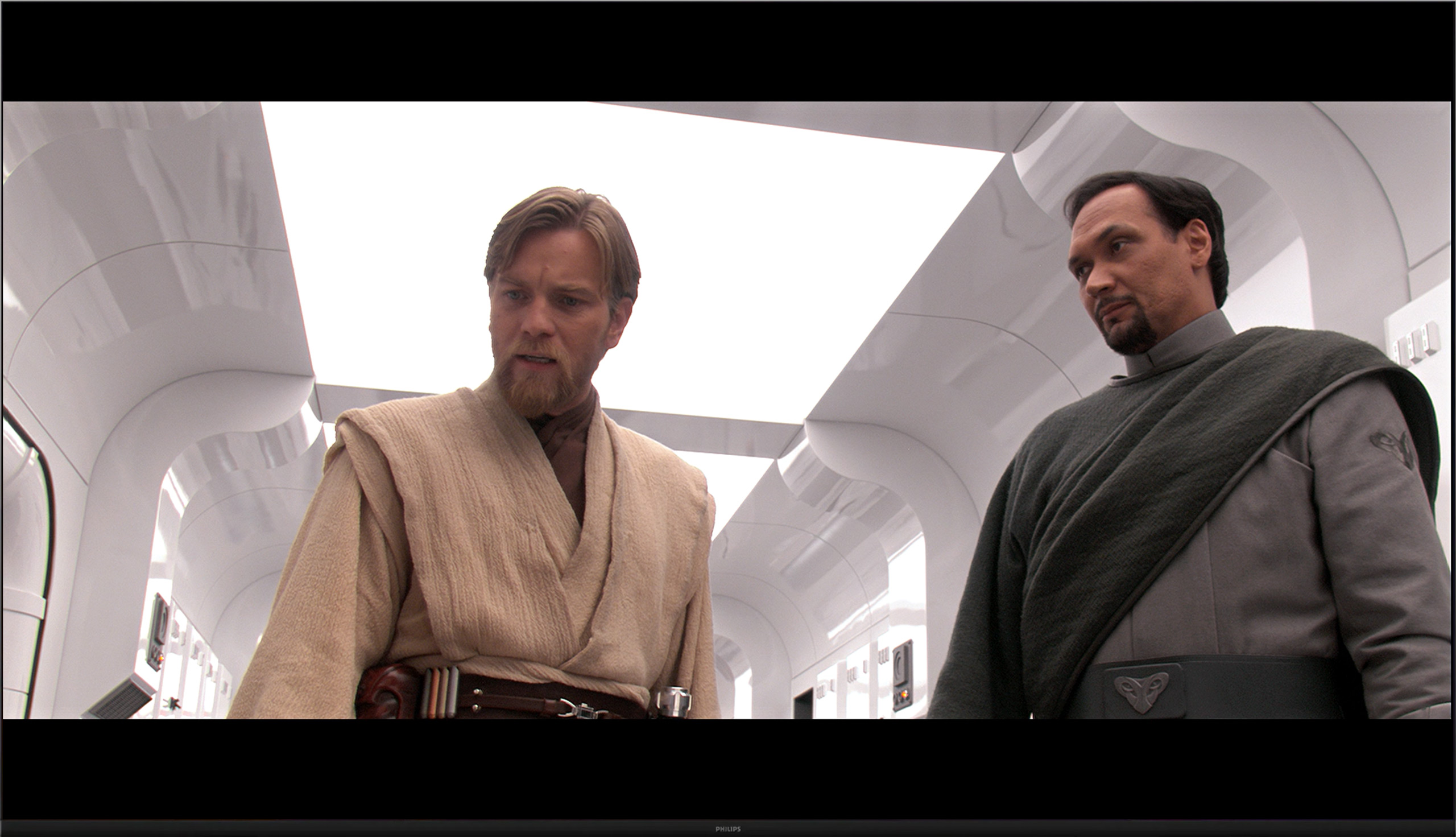
Factory Mode
After calibration
The most faithful factory mode in terms of compliance with the source material turned out to be "Film", which was used in our tests. Nevertheless, like other factory modes, it also had its flaws. In both SDR and HDR materials, we noticed issues with white balance, where the dominance of green and red resulted in a yellowish tint. This effect was particularly noticeable in the form of yellowed whites and unnatural skin tones. The "ColourChecker" palette test showed that every colour had shifted to warmer tones, affecting colour reproduction accuracy. A key aspect of the image is also contrast and brightness, which can be assessed by analysing gamma charts and the EOTF curve. On the gamma chart, we noticed significant deviations – both excessively high values, which caused loss of detail in the shadows, and excessively low values, which led to a drastic drop in contrast. Compared to gamma, the EOTF curve performed better, only slightly brightening the image, which had a less negative impact on overall quality.
We tested the television with the best available factory settings, namely in Film/Filmmaker mode – this is the mode we recommend for everyday viewing. Unfortunately, it is not without its flaws. Both in HD and HDR content, the image had a noticeable tendency to a pink tint, caused by an excessive amount of red and blue in the white balance. Another issue turned out to be excessive brightness in the image, which was confirmed by both the gamma chart and the EOTF curve. This feature was responsible for loss of detail and washed-out colours in more challenging HDR scenes that we mentioned earlier. The overall result led to significant colour reproduction errors – in extreme cases, the delta E value exceeded 7, while the threshold for visible errors for the human eye is around 3. This situation can be improved with calibration, and you can read about its effects below.
Color reproduction after calibration
5/10
8.4/10




Philips, both in its cheaper and more expensive models, offers a wide range of tools for image calibration. We used them to improve the quality of the displayed image, although it was not as straightforward as it might seem. We managed to adjust the white balance, improve the gamma, and fine-tune the EOTF curve, but despite these efforts, the deltaE errors were still at a very high level. The main causes were limited coverage of the DCI-P3 palette and low maximum brightness, which significantly affected the final result. Although the overall presentation is much better, the design features of the television did not allow us to achieve spectacular results.
The Dutch manufacturer offers quite a sizable amount of settings in its products, so as usual, we decided to tinker with them a bit. The effects are immediately noticeable – we managed to correct the white balance, which made the image stop appearing excessively pink. The brightness characteristic has also been partially evened out, of course, within the limits set by the television itself. The image is no longer overly exaggerated, and the overall reception after calibration is definitely better than in the factory settings of the Filmmaker mode.
One could only critique the EOTF curve characteristic, which still indicates that the image has a tendency to brighten HDR materials. Despite our efforts, the darkest parts of scenes are still sometimes too bright, and the brightest ones do not always achieve their full contrast potential. However, it must be clearly stated that we are dealing with a typically budget construction – one cannot expect reference-level reproduction of HDR content from it.
Calibration has definitely helped this model – it improved the balance, toned down the aggressive colour palette, and brought the image closer to what one might expect from a well-configured movie mode. However, there are certain limitations that cannot be overcome.
Smoothness of tonal transitions
8.4/10
6.3/10





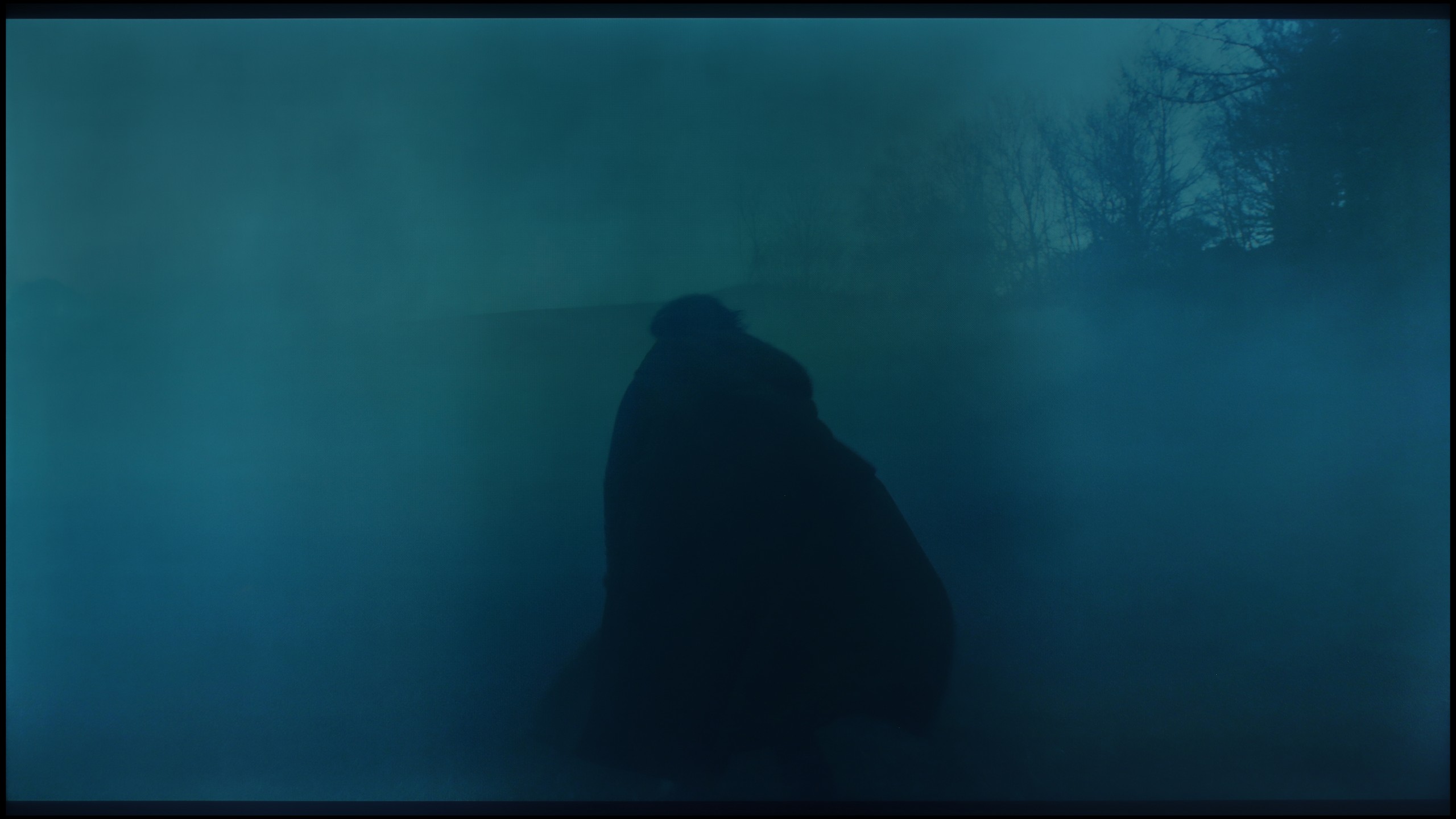

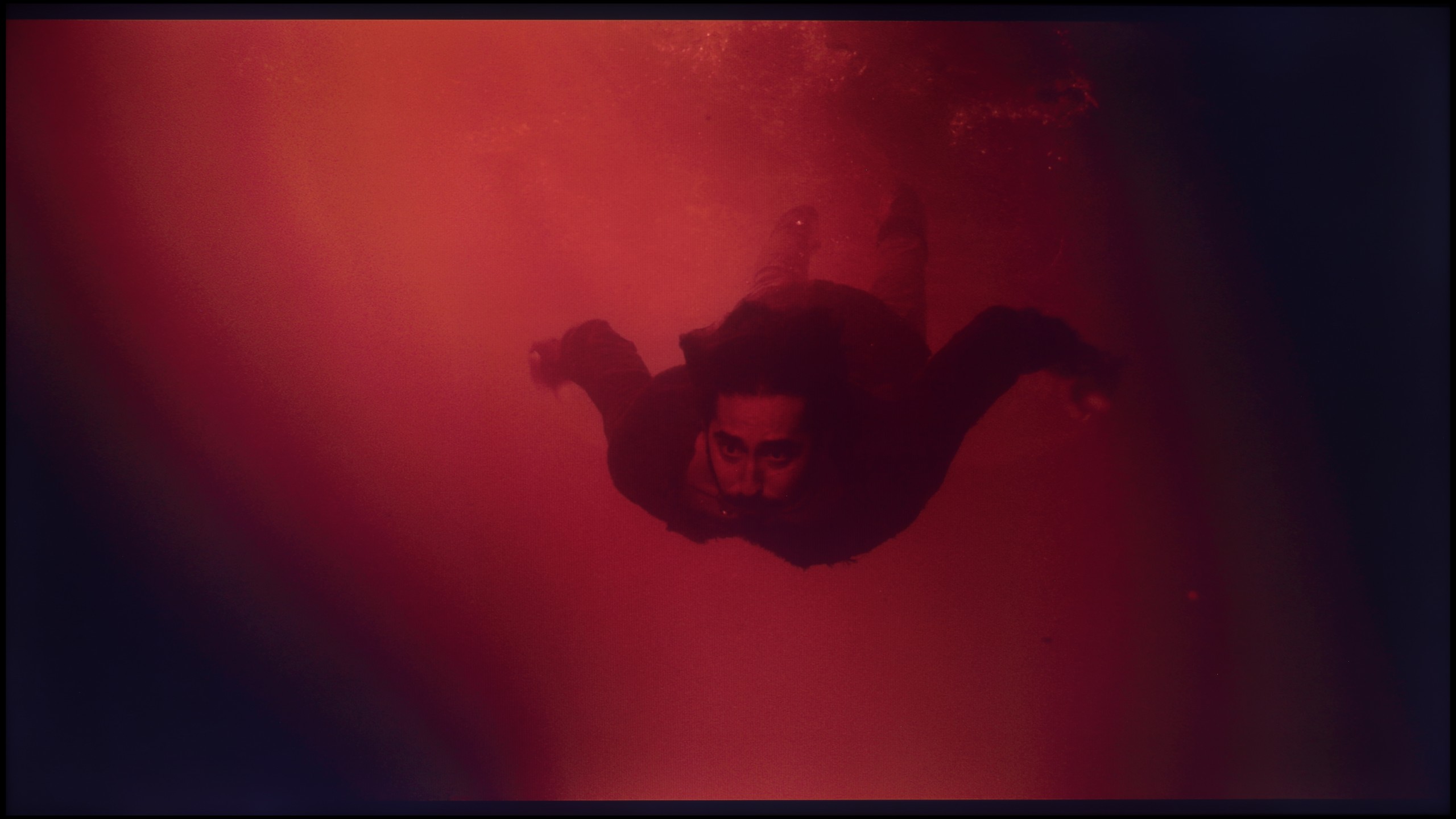




The gradation of tonal transitions in the Philips PUS8359/12 television is at a good level, without any obvious issues that could negatively impact the quality of viewing content. Upon closer observation, one can notice slight imperfections in bright, colourful transitions, however, they are subtle enough that most users are unlikely to notice them or consider them a problem.
The PUS8560 handles colour transitions into smooth gradients very well. During tests, the image appeared coherent and natural, and serious issues with tonal transitions occurred only in very dark scenes – for example, in a shot with red water, where subtle cuts between colours could be noticed. However, these are rather exceptions that do not spoil the reception of most content. It is worth mentioning another phenomenon that more significantly affects the quality of the image – the so-called dithering, which refers to a slight "tingling" visible on uniform backgrounds. This effect can be particularly noticeable in high-quality materials and can somewhat spoil the impression of image clarity. It is for this flaw that we deducted some points in our evaluation.
Image scaling and smoothness of tonal transitions
6/10
6.1/10
Smooth transition function

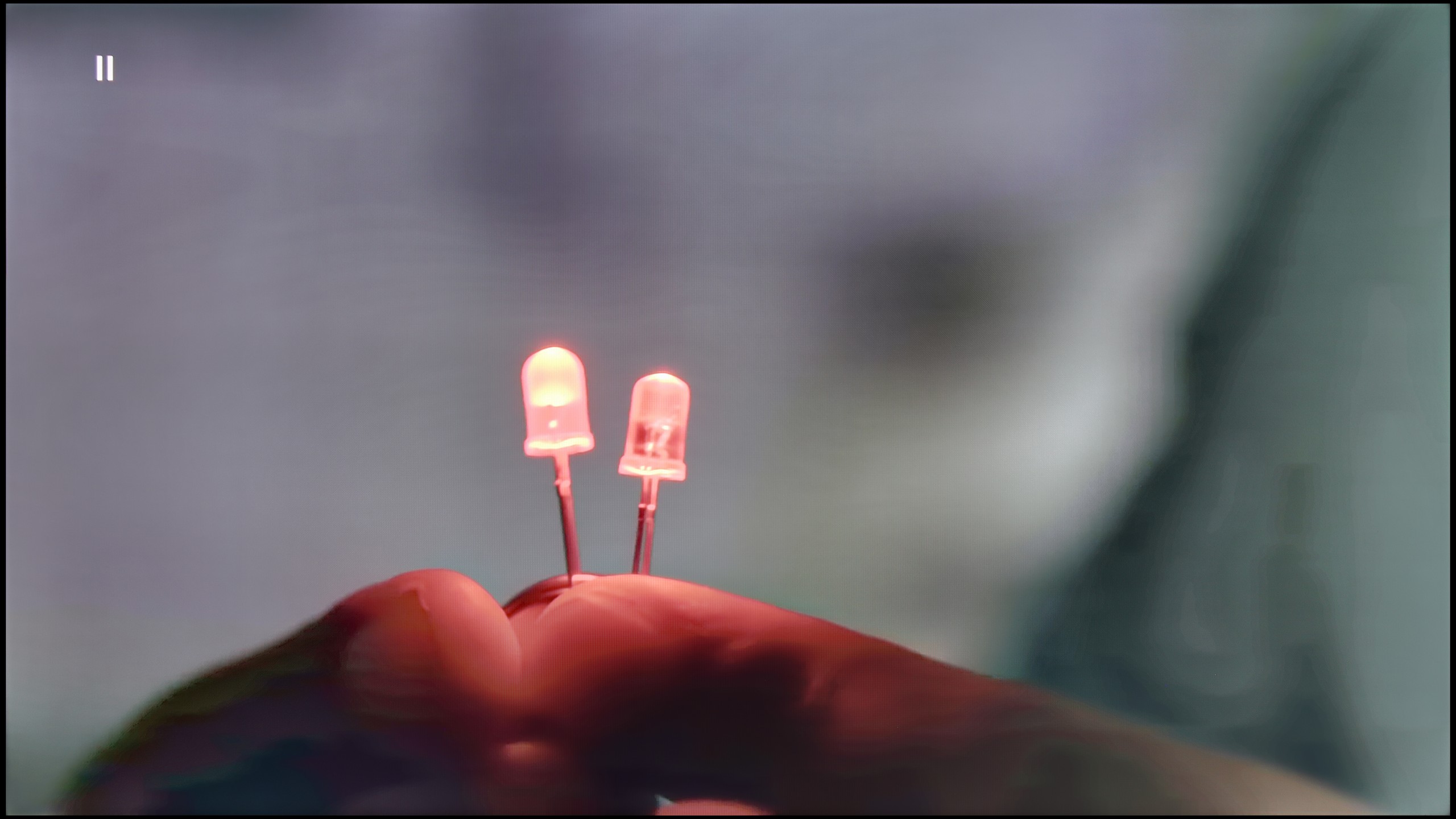
Image without overscan on the SD signal


In this paragraph, we will take a look at two functionalities. Once again, we will examine the feature responsible for tonal transitions, but we will also check how the television handles image scaling. The option responsible for smooth gradation is called "Distortion Reduction". As we have established, it quite effectively smooths out irregularities. However, we must point out two things: we are unable to enable it for HDR materials, and that it blurs details in films.
The tested television cannot boast the best image scaling. The overall blurriness of the image is quite noticeable, but worse still, it blurs details. This is particularly evident on the branches and the model's hair. A characteristic white halo around the figures is also visible.
Philips PUS8560 offers a function for reducing posterization, hidden under the name "distortion reduction". And although it indeed fulfills its role by smoothing out problematic tonal transitions, it works a bit too broadly. In practice, it affects not only colourful gradients but also softens faces, the textures of clothing, and the surfaces of furniture. This compromises the authenticity of the image – especially in films where natural texture is very important. However, if someone is looking for smoothing at all costs, it's best to set this option to "Low". For cinema image enthusiasts – we definitely do not recommend it.
On the positive side, the quality of upscaling older materials is noteworthy – the PUS8560 model handles them surprisingly well. The image retains its natural softness, without artificially boosted sharpness. It is also worth mentioning that the television correctly displays content with very low resolution, avoiding issues with image edge cutting (so-called overscan).
Blur and motion smoothness
4/10
4/10


Blur (native resolution, maximum refresh rate):





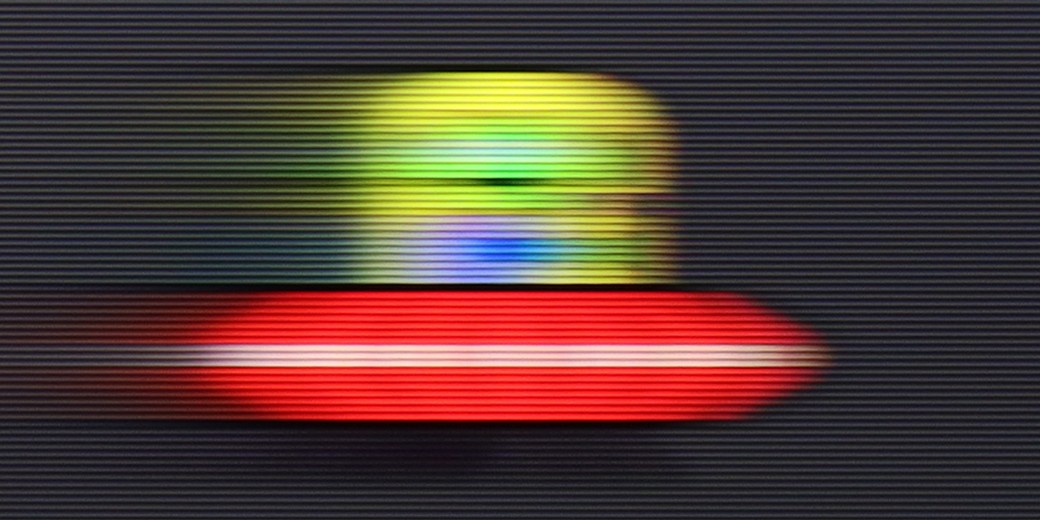
Philips PUS8359 is not the best choice for watching sport. The lack of even basic motion smoothing functionality means that the image during fast-moving scenes is not adequately clear. Despite the use of an IPS panel (43 and 55'), which theoretically should offer better sharpness than VA panel variants, there is no noticeable improvement regarding blurring. In pictures with fast movement, the figure of the alien is clearly blurry, indicating that the television struggles to maintain sharpness in dynamic shots.
The Philips PUS8560 is a television equipped with a panel featuring a refresh rate of 60 Hz, which immediately limits its capabilities in terms of displaying dynamic content. Watching sports or playing on a console is not particularly enjoyable. The situation is further worsened by the lack of any option to improve the smoothness of films. In the menu, we won't find settings that would allow us to enable a motion smoother or even a slight motion smoothing for films recorded at 24 frames per second. You can imagine the effect. The image can appear jerky, especially in shots with panoramic camera movements.
Console compatibility and gaming features
4.7/10
4.7/10
- ALLM
- VRR
- VRR range48 - 60Hz48 - 60Hz
- Dolby Vision Game Mode
- Correct implementation of HGIG
- 1080p@120Hz
- 1440p@120Hz
- 4K@120Hz
- Game bar

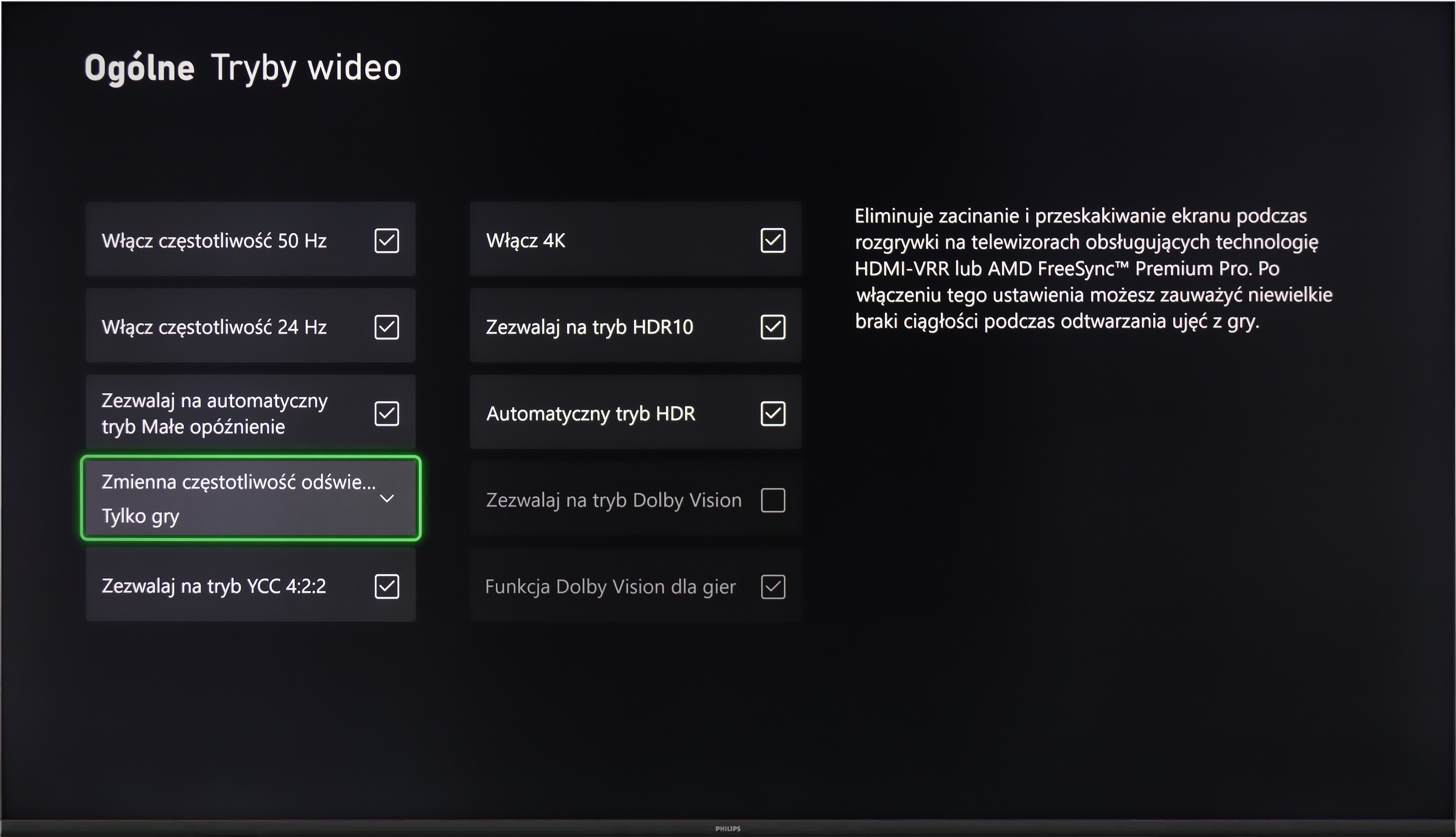

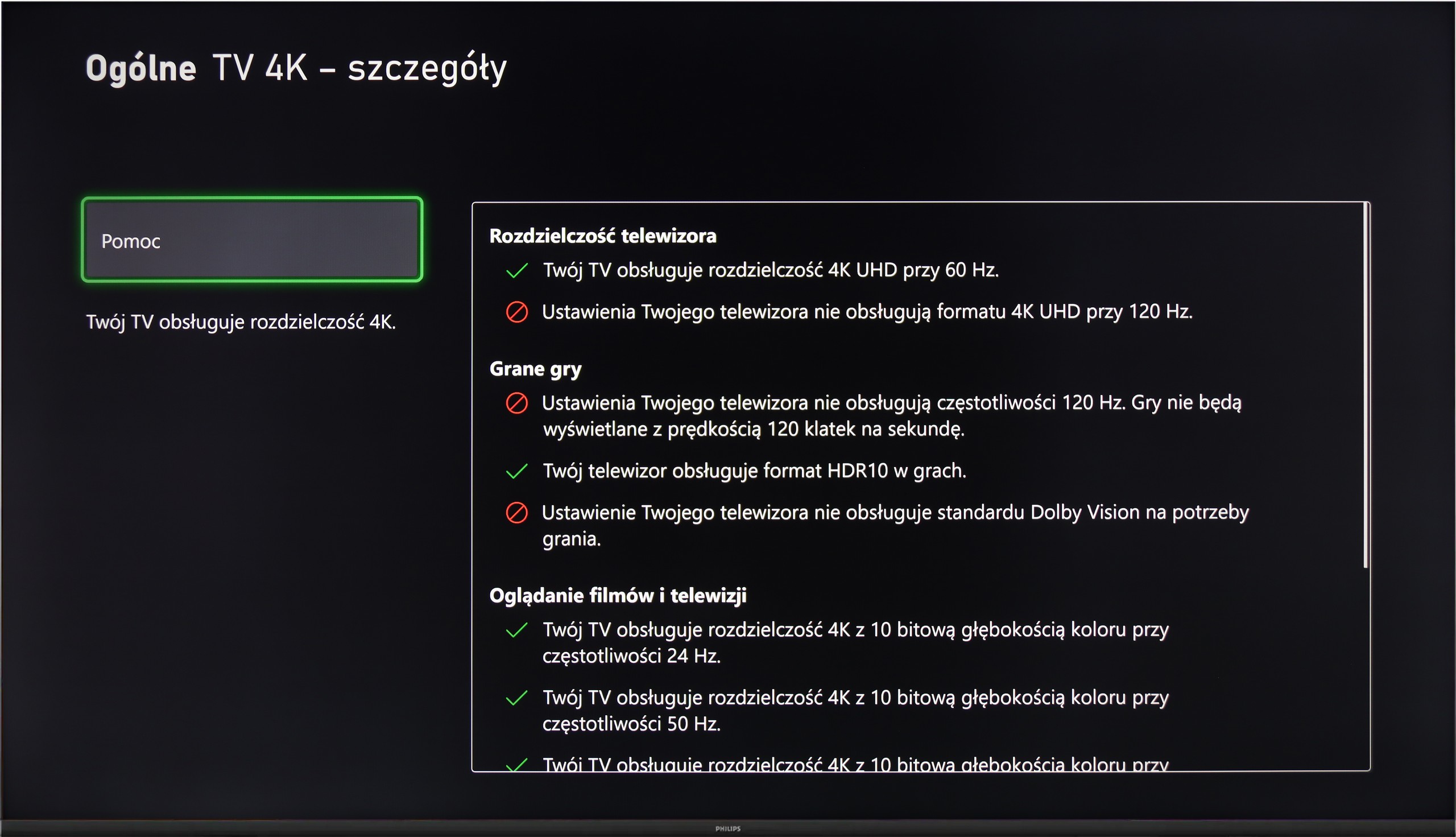

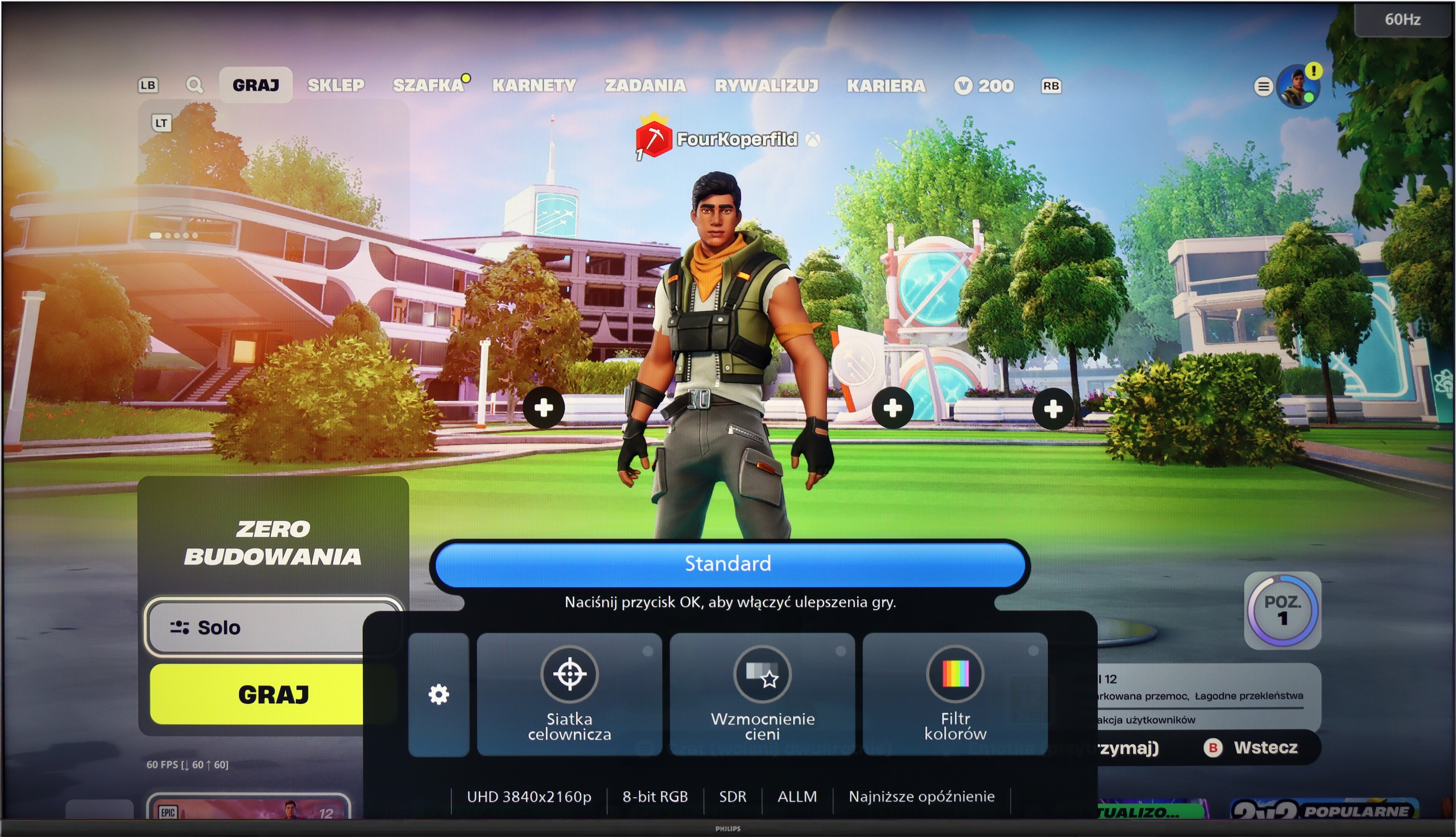

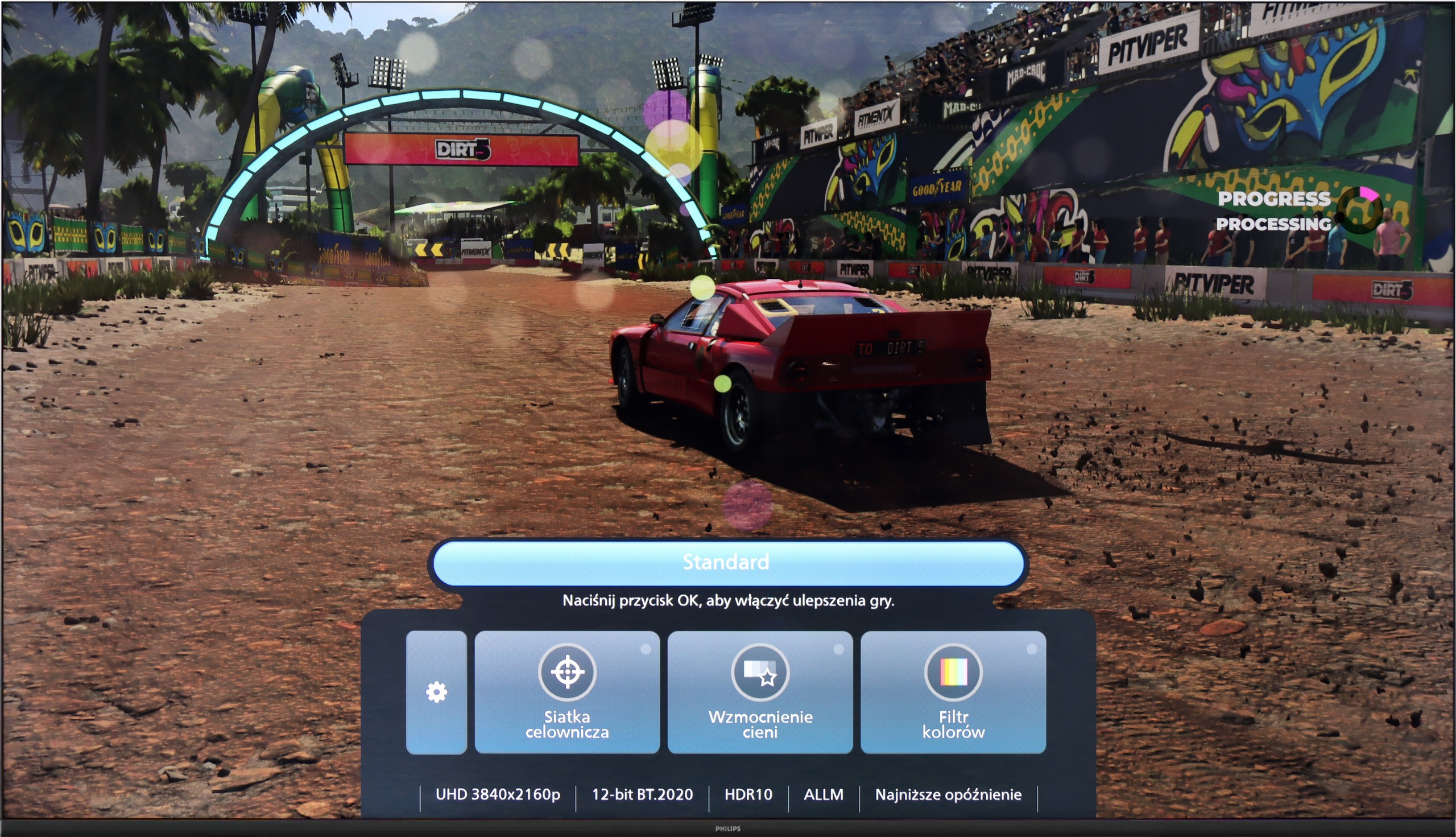
In terms of compatibility with consoles, Philips PUS8359 is mainly suited for occasional gamers. Although the television is equipped with an HDMI 2.0 port, it offers features such as Auto Low Latency Mode (ALLM), Variable Refresh Rate (VRR), and Game Bar. ALLM automatically switches the television to low latency mode, making quicker reactions easier during gameplay, while VRR smoothly adjusts the refresh rate, eliminating screen tearing issues. The Game Bar provides quick access to game settings and real-time monitoring of parameters; however, in our opinion, it performs worse compared to the competition's solutions.
However, more demanding gamers may feel unsatisfied. Philips PUS8359 does not support advanced HDR formats in games or higher refresh rates, which is due to the use of a 60 Hz panel. These shortcomings limit the television's capabilities in delivering smooth and detailed experiences during fast, dynamic gameplay.
Although the Philips PUS8560 is not designed with gamers in mind, the manufacturer has decided to equip it with a few features that may prove useful when connecting a console. On board, we find automatic switching to game mode (ALLM), as well as a simple connection status information bar – the so-called Game Bar. It does not make a particularly strong visual impression, but it serves its purpose. The presence of variable refresh rate (VRR), operating in the range of 48 to 60 Hz, may come as a surprise. While this is not a wide range, in the case of less demanding games or titles with unstable frame rates, VRR can help reduce screen tearing. However, this is the only element that could be considered beyond the minimum.
It must be made clear that the PUS8560 is not equipment for gamers looking for a responsive screen and full support for modern console features. It lacks HDMI 2.1 ports, the refresh rate is limited to 60 Hz, and the response time of the panel is not among the fastest. This model may be suitable at most for casual gamers who want to enjoy the Ambilight system.
Input lag
10/10
10/10
SDR
HDR
Dolby Vision
Philips PUS8359 offers an exceptionally low input lag of below 10 ms, which is an excellent result. This makes the television perfect for dynamic games, providing quick responses and smooth gameplay, something that both casual and more demanding gamers will certainly appreciate.
The input lag on the PUS8560 is very good. When we previously mentioned that this screen is rather for the "casual gamer," there is nothing to be ashamed of in this regard – even when compared to screens aimed at gamers. Results around 12 ms are truly outstanding, allowing for an enjoyable responsive gameplay experience. It doesn't matter whether we are playing in Full HD or 4K – the lag remains equally low, so if you value a quick response time, the PUS8560 will definitely not disappoint in this aspect.
Compatibility with PC
6/10
5.6/10

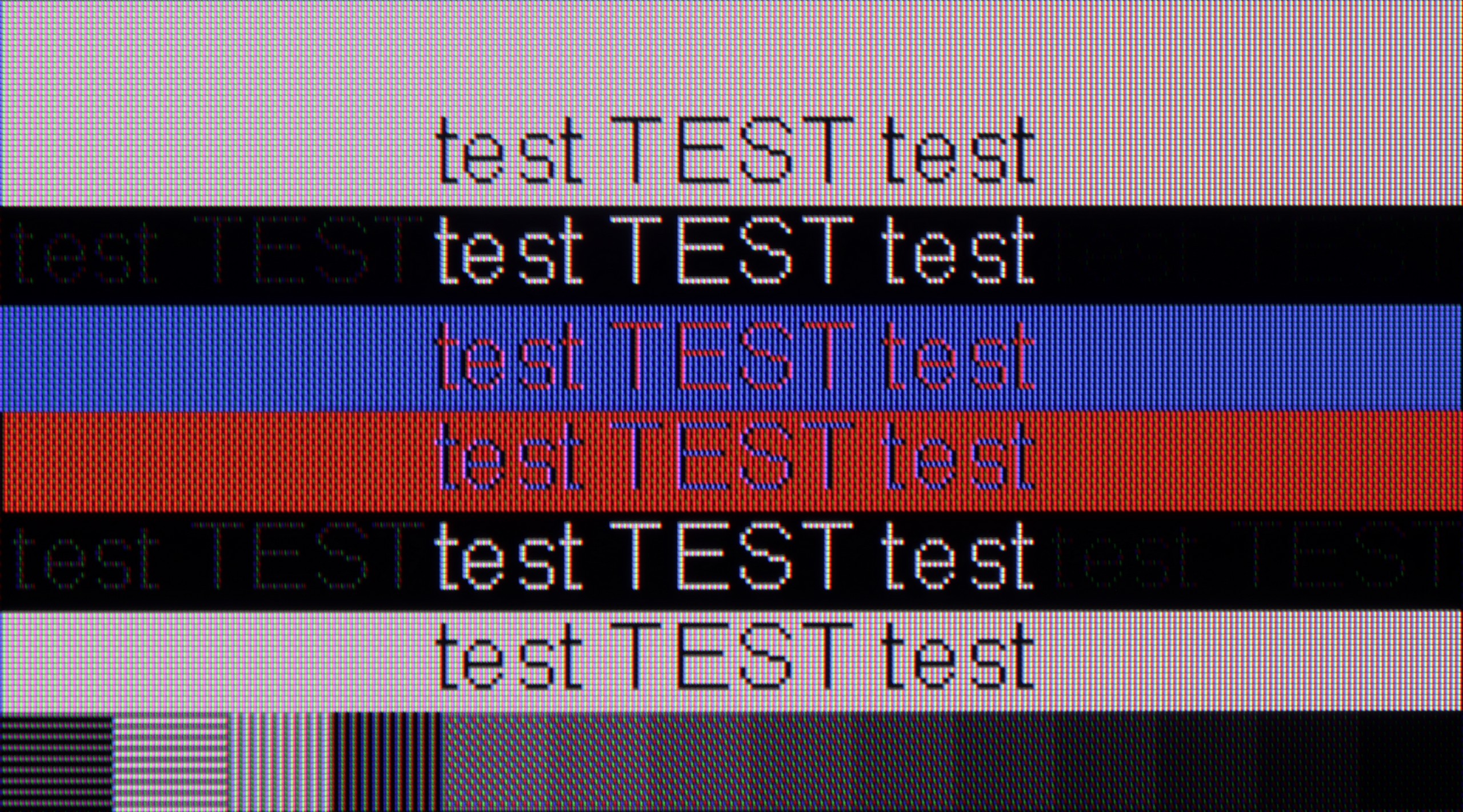
The Philips PUS8359/12 television with an IPS panel offers quite good font readability thanks to its support for 4:4:4 chroma, making it suitable for office work and everyday computer use. Although its low input lag makes it friendly for gamers in terms of response time, the lack of G-Sync support and its 60 Hz panel may not meet the expectations of more demanding users. For those looking for a television for gaming, this might be a compromise – quick response is present, but the lack of higher refresh rate and adaptive image synchronisation affects its assessment in the gaming category.
When it comes to working with a PC on the PUS8560, it looks... quite strange. Chroma 4:4:4 is present in "Monitor" mode, but there is a problem with grey fonts – not all subpixels are lit, which results in the text appearing jagged. On the other hand, in "Game" mode – chroma 4:4:4 disappears, but the grey fonts look correct. In practice, we are therefore forced to juggle settings if we want to have perfectly readable text at all times. And what about gaming on the computer? Our opinion remains the same as for consoles – it is doable, but without fireworks. There is no variable refresh rate for G-SYNC graphics cards, and the refresh rate itself remains relatively low. However, we can once again highlight the very low input lag, which saves the situation in dynamic games.
Viewing angles
6.3/10
3.3/10
The viewing angles on the Philips PUS8359 television are quite good, thanks to the IPS panel used (43" and 55"). The picture remains readable and clear even when viewing from a greater angle, which is beneficial when watching content with a larger group or in rooms with an unconventional layout.
The viewing angles on the PUS8560 are precisely what one would expect from a VA panel - it's not the best. The image loses quality even with a slight shift off-axis – colours become washed out and black begins to resemble a dark navy. This is, of course, the price paid for the better contrast that VA offers when viewed directly. In the case of our 55-inch model, this is still acceptable, especially if the television is positioned perfectly opposite the sofa. However, with larger screen sizes or a less central placement in the living room – it could become a problem for comfortable viewing.
TV efficiency during daytime
4.3/10
4.9/10

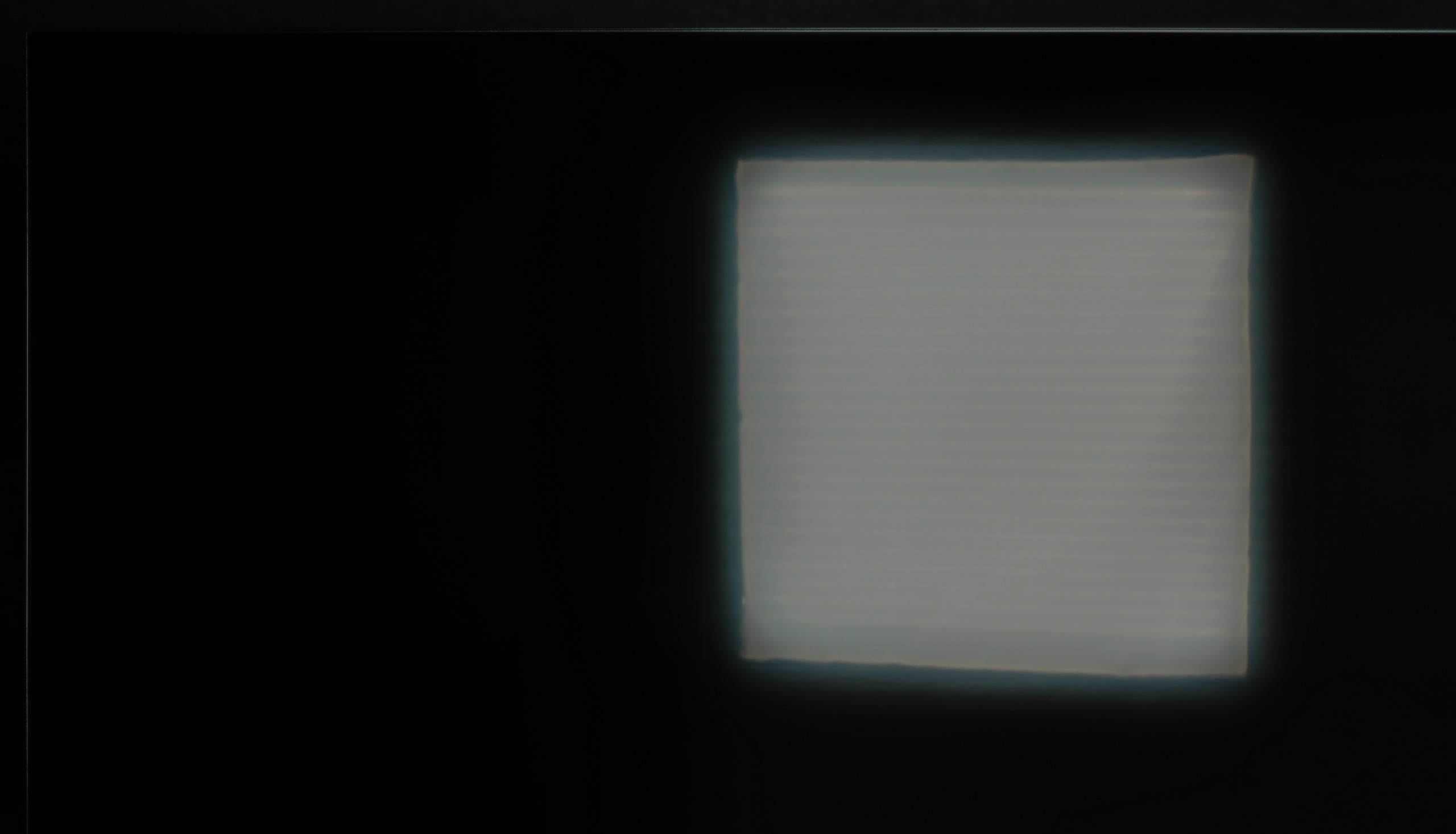

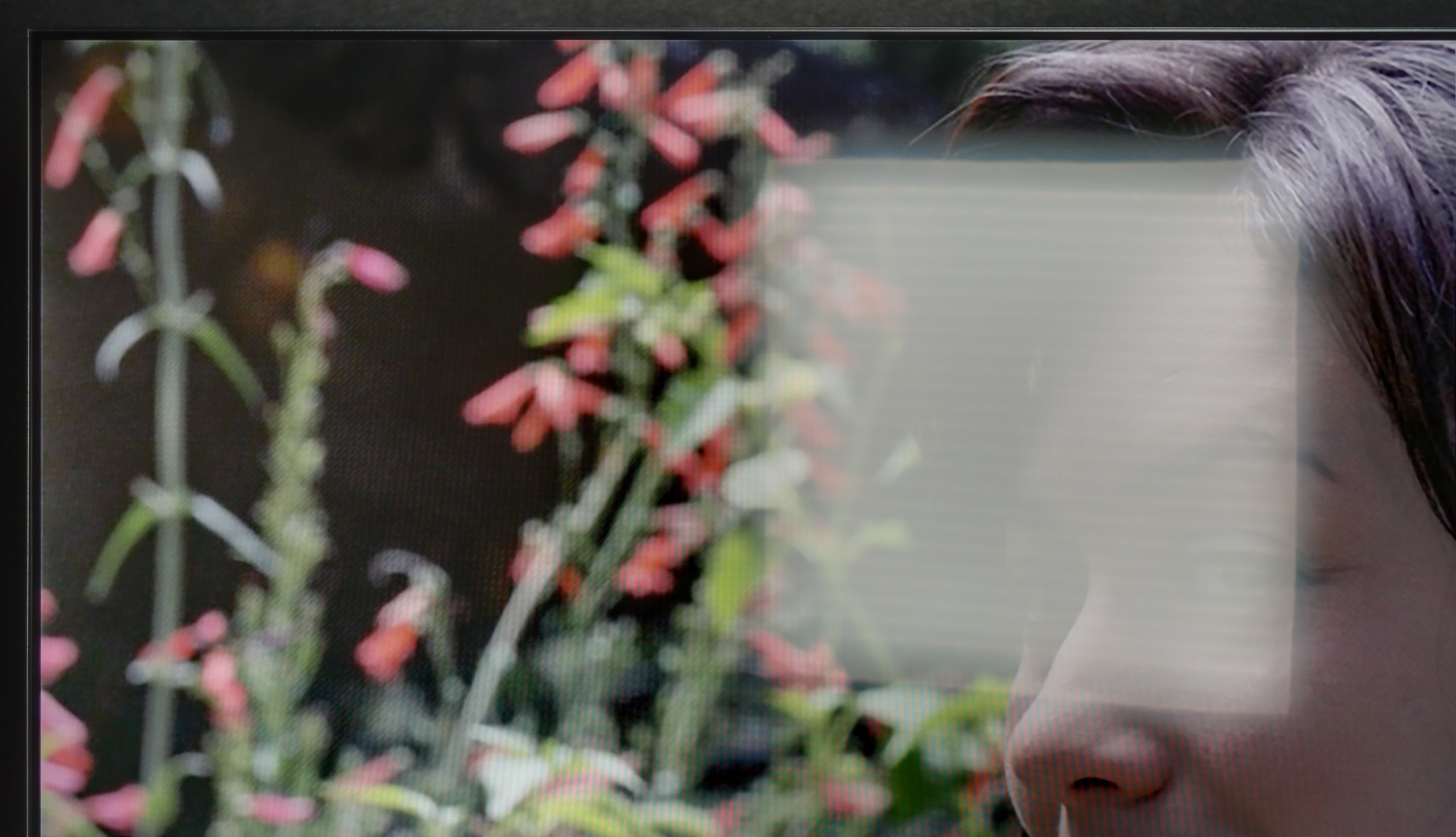
Matrix brightness
Average luminance SDR
Philips PUS8500 : 331 cd/m2
Philips PUS8359 (IPS): 305 cd/m2
In terms of performance during the day, Philips PUS8359 performs average. The satin finish of the panel moderately reduces reflections, which may be noticeable in bright rooms. A brightness level of 300 cd/m² is acceptable in this price range, but one should not expect exceptional results in more challenging lighting conditions.
The PUS8560 performs moderately during the day. The satin matrix coating quite effectively dampens reflections, which means that light from windows or lamps does not interfere too much. The blacks also look decent for a VA panel – even in daylight, there are no significant losses in contrast. However, all the charm fades when it gets really bright. The panel's brightness is around 300 nits, which is definitely too little to speak of full comfort in a heavily lit room. In such conditions, the PUS8560 simply needs to be aided by blinds – otherwise, the image begins to look rather pale.
Details about the matrix
Subpixel Structure:

Panel uniformity:
Philips PUS8359 (IPS)
Philips PUS8500
TV features
5.7/10
4.9/10
- HDMI inputs3 x HDMI 2.0, 0 x HDMI 2.13 x HDMI 2.0, 0 x HDMI 2.1
- OutputsToslink (Optical audio), eARC (HDMI), ARC (HDMI), Mini-Jack (Headphones)Toslink (Optical audio), eARC (HDMI), ARC (HDMI), Mini-Jack (Headphones)
- Network InterfacesWi-Fi 2.4GHz, Wi-Fi 5GHz, Ethernet (LAN) 100MbpsWi-Fi 2.4GHz, Wi-Fi 5GHz, Ethernet (LAN) 100Mbps
- TV receptionDVB-T, DVB-T2, DVB-S, DVB-S2, DVB-CDVB-T, DVB-T2, DVB-S, DVB-S2, DVB-C
Classic features:
- Recording to USB (terrestrial TV)
- Recording programming
- Picture in Picture (PiP)
- RF remote control (no need to aim at the screen)
- Backlit remote control
- Teletext
- Audio only mode
- Possibility to connect Bluetooth headphones to the TV
- Possibility to simultaneously use Bluetooth headphones and the TV speaker
Smart features:
- AirPlay
- Screen mirroring (Windows Miracast)
- Wyszukiwanie głosowe
- Voice search in native language
- Ability to connect a keyboard and mouse


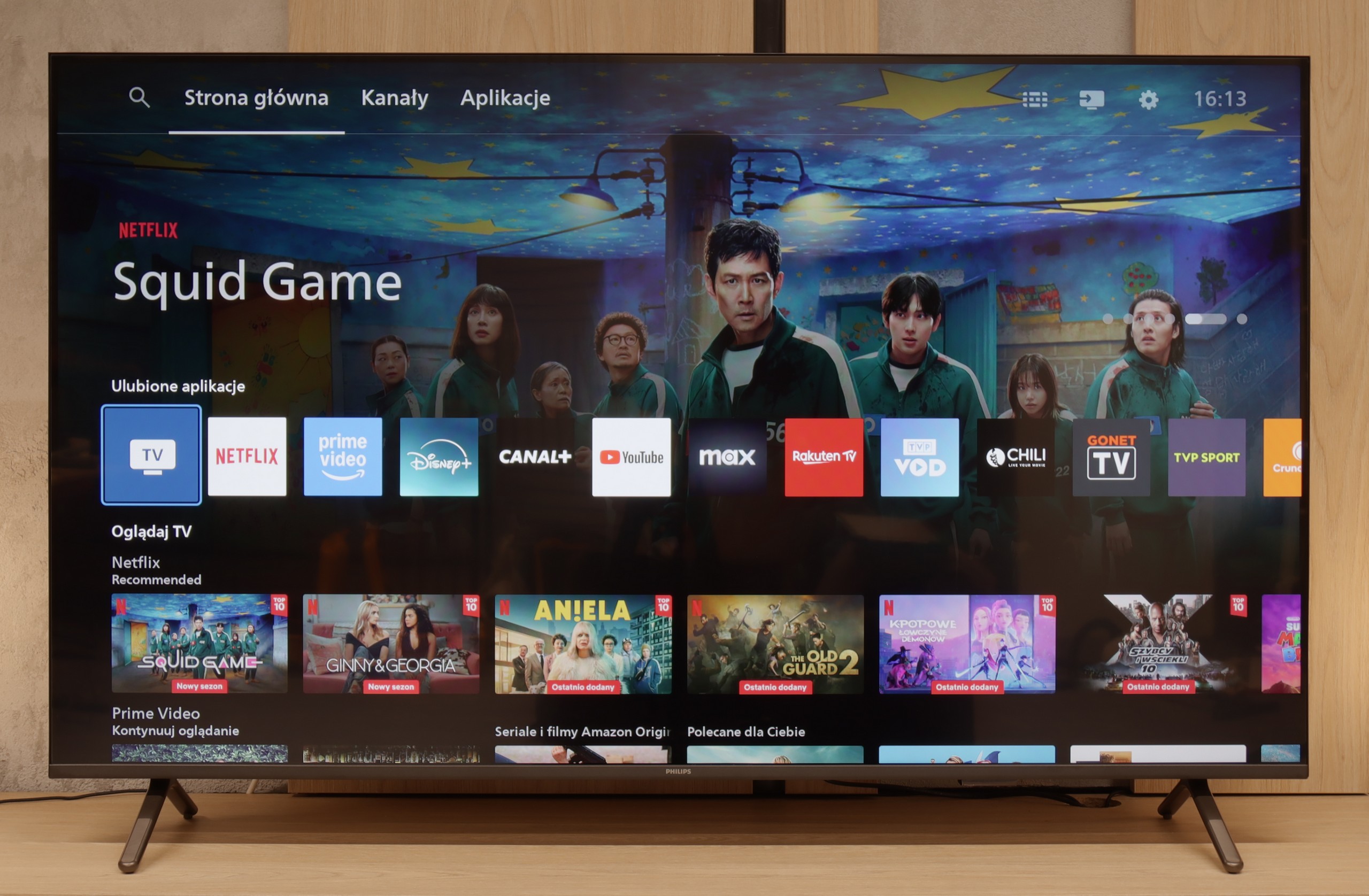
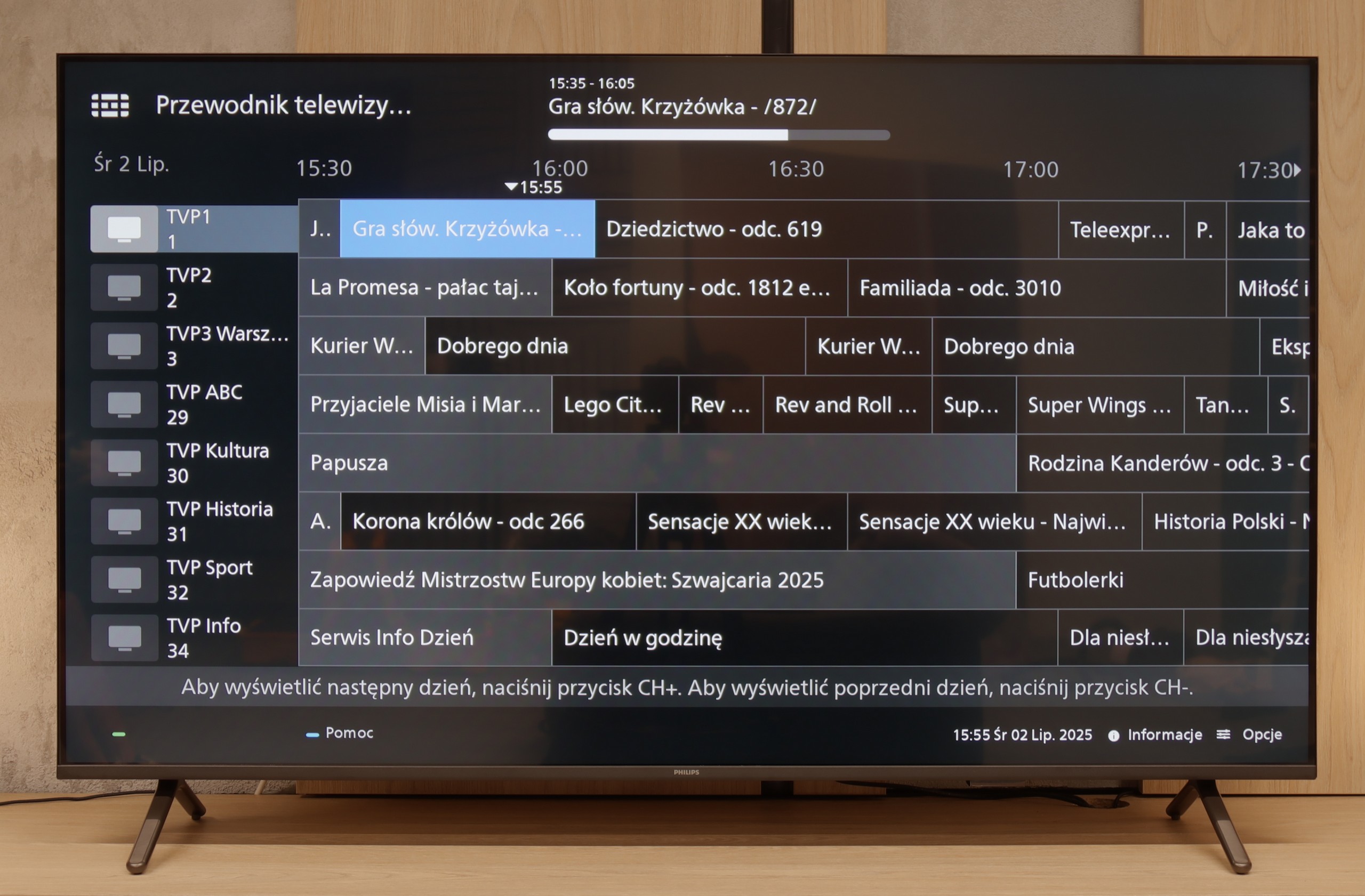
Philips has decided to change its approach to the operating system this year, replacing the previous open system GoogleTV with its proprietary TitanOS. As is often the case with new solutions, TitanOS faces typical growing pains. Currently, it only offers basic applications, and the app store leaves much to be desired, which may disappoint users expecting a rich selection of programmes. Additionally, the lack of support for AirPlay features and the inability to record to USB represent further limitations that could affect the overall user experience.
An interesting feature of the models with TitanOS is the new remote control, which is very convenient to use thanks to its backlighting. Unfortunately, its wireless functionality is not entirely consistent. The hybrid design means that sometimes you need to aim at the television, and other times you don’t—this depends on the buttons being used. It is simply frustrating.
The most important feature of the Philips PUS8359 television is the three-sided Ambilight system, which significantly enhances the viewing experience. The LED lighting placed on the sides and top of the television creates an immersive effect, extending the image beyond the screen and matching the colours to the displayed content. For many users, this is a key element that makes viewing more engaging and sets the television apart from the competition.
Classic TV Features:
If you are looking for a television that "works" in the most basic sense – the PUS8560 will fulfil that role. In terms of classic features, we have a rather minimalist set. On the plus side, there is an electronic programme guide (EPG), teletext, a backlit remote control with a classic numeric keypad, and a headphone jack input. It sounds a bit like a dream set for seniors – and there is some truth to that. However, it must be stated clearly: this is a television with very limited capabilities. We will not find recording functions from DVB tuners to USB here, nor is there a PiP mode or other conveniences known from more expensive models.
Smart TV:
How does the SmartTV perform on the PUS8560? Well, this is where it gets a bit more complicated. The PUS8560 runs on the Titan OS, which in this particular implementation posed significant problems. Some features, although present "on paper," simply did not work. For example: Wireless screen mirroring functions, such as Chromecast or Miracast – we tried to activate them from several different phones and laptops… without success. Perhaps this will be fixed in the future, but at the time of testing – it did not work. Additionally, the system's speed left much to be desired – switching between applications or home screens was simply slow. A considerable portion of the menu functions seems to be well hidden in the depths of a poorly organised system. To make matters worse, the library of available applications is quite limited. Even though the situation with applications is better than last year, it is still far from ideal. The situation tries to be salvaged by a modern remote – slim, elegant, backlit, and really well made. Unfortunately, it operates on classic infrared, so you have to aim it at the screen. The only exception is voice control, which works via Bluetooth… it’s just a pity that it doesn’t support Polish.
Playing files from USB
8/10
8/10
Supported photo formats:
Maximum photo resolution:

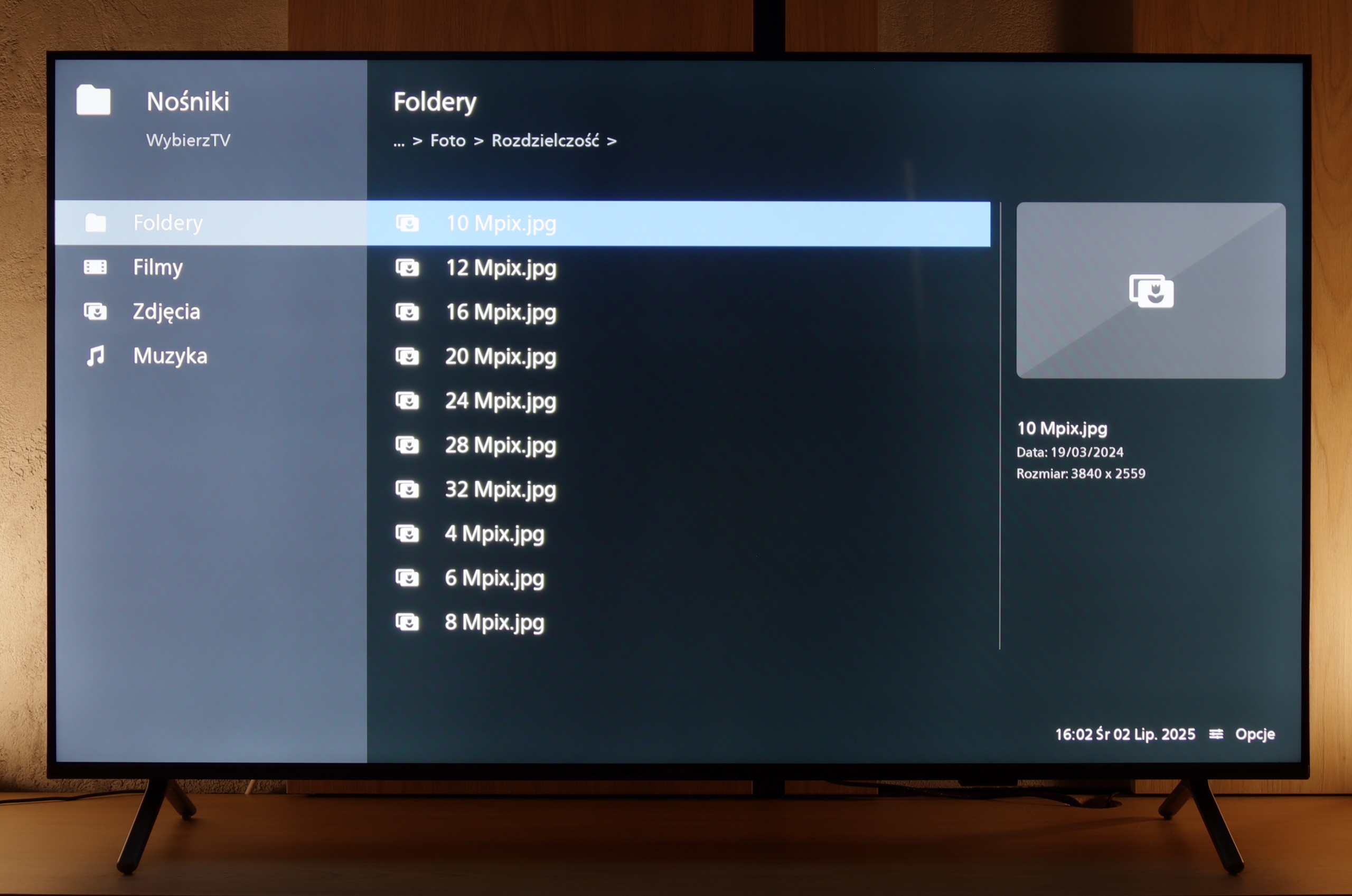
The default media player integrated into Philips PUS8359 offers quite a wide range of capabilities, but it also has its limitations. It can play almost all video formats, with the obvious exception of Dolby Vision and the less obvious .asf, which is not commonly found. However, the problem lies in the absence of the H.265 HEVC codec with high bitrate. When it comes to photos, the player performs adequately, but it lacks support for some popular resolutions and formats, such as HEIC, used on Apple devices. The player performs best with audio, where it cannot be faulted. Unfortunately, due to system limitations, there is no way to expand its features, which means we have to make do with what the manufacturer has provided.
The PUS8560 handles the playback of most popular video and audio formats from a USB memory stick without any major issues, so there’s no point in detailing the compatibilities one by one. In everyday use, it should simply work – and it does. The only thing worth noting is the handling of images. Although the television easily recognises popular file extensions, there are instances when some images simply do not display when the graphic files have very high resolutions. This may not be a huge problem, but it’s good to keep it in mind, especially if we want to view photographs straight from the camera. Apart from that, the PUS8560 shouldn’t pose any significant issues with playing files from USB.
Apps
6.2/10
4.6/10














































Sound
6.1/10
6.2/10
- Subjective sound quality:6.1/106.2/10
- Dolby Digital Plus 7.1:
- Dolby True HD 7.1:
- Dolby Atmos in Dolby Digital Plus (JOC):
- Dolby Atmos in Dolby True HD:
- DTS:X in DTS-HD MA:
- DTS-HD Master Audio:
The audio system in the Philips PUS8359 is a standard configuration of 2x10 W speakers, which is unlikely to impress high-quality audio enthusiasts. At moderate volumes (up to 50% of the maximum level), the sound remains bearable and does not cause major distortions. For better audio experiences, we definitely recommend connecting even a simpler soundbar. With support for Dolby Atmos and DTS, the television works well with external audio systems.
The television sounds quite pleasant and can confidently be regarded as having sufficient sound levels for most users – both for watching everyday programmes and for an evening viewing of a series. Moreover, a pleasant surprise is that even in this budget-friendly series, Philips has chosen to acquire licenses for full audio formats such as Dolby Atmos and DTS. This is great news for owners of home cinemas and soundbars, as it means full compatibility and no need to "fiddle around" with connecting external devices.


